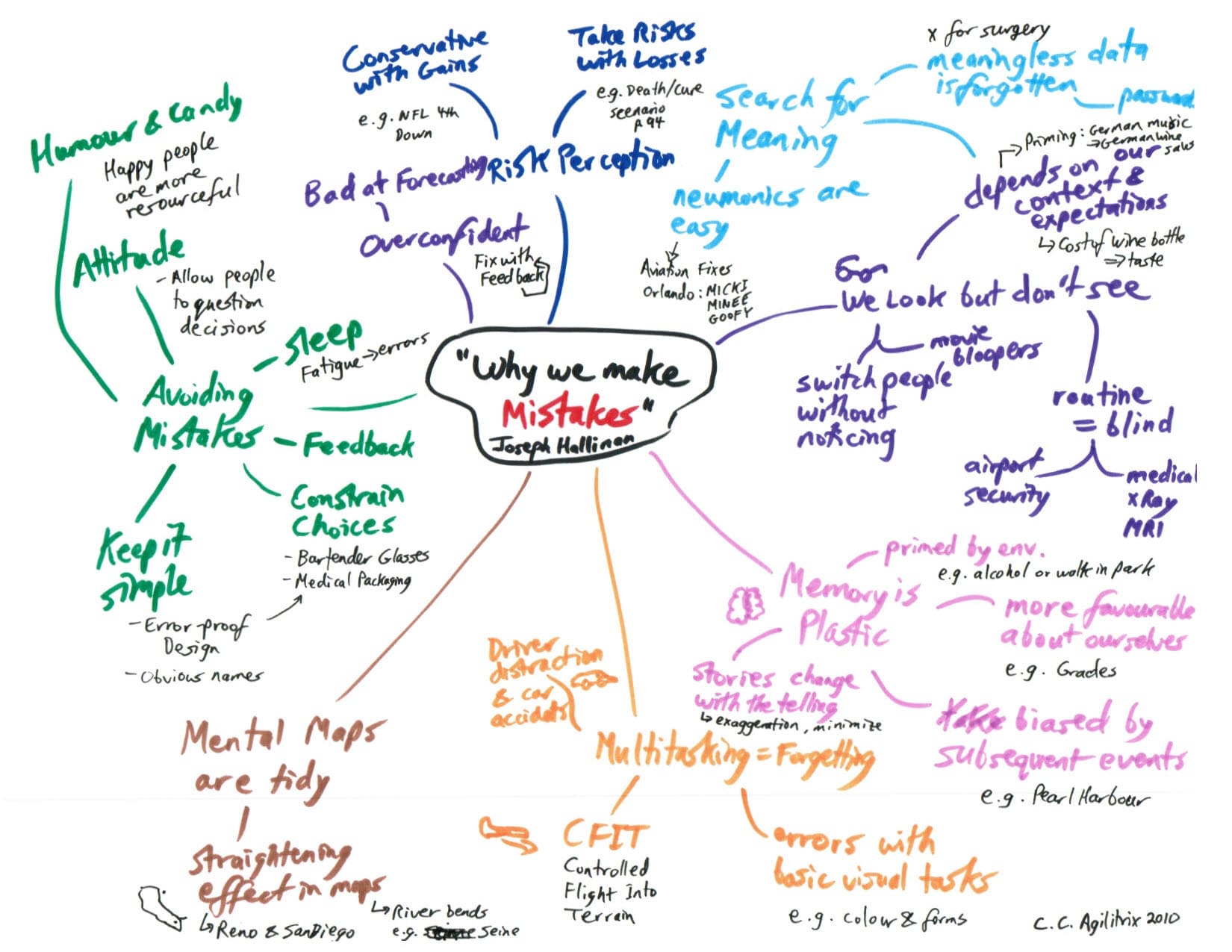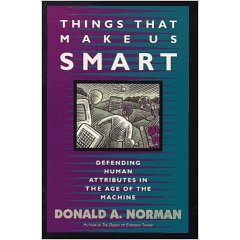Why We Make Mistakes
Joseph T. Hallinan
Summary:
Chapter 0:In this introduction to the book, Hallinan discusses how frequent mistakes are done. He claims people more than often attribute the fault of a mistake to the person who committed the mistake, instead of anything else (the car example). We are willing to take the bad of things in order to get the good part of it, and world we live in is not helping us. Hallinan claims that being aware of our acts should help us decrease our mistakes (the multiple item sale).
Chapter 1: Not being able to see (observe and catch details) of things in front of us is a cause of mistakes. We only see a fraction of what we think we are seeing, our focus is in only one thing, and what is in the background is very blurry. We notice on a Need-to-Know Basis, noticing only things that are important or relevant to us, and ignoring the rest.
Chapter 2: We are able to better remember things when they have a meaning to us, than meaningless things. For example remembering the features of a penny, remembering faces better than names, being able to remember random things by giving them some kind of meaning, and how we can mistakenly recognize a face by things that are not enough and easily confused.
Chapter 3: Individuals make choices based on "invisible" factors. For example making judgments of people based on pictures only, how a woman's physiology affects men reactions, and how students feel about chaining answers in tests (something contrary to what researchers have discovered).
Chapter 4: The overall idea of this chapter was about the tendency to see and remember things in a way that is "self-serving," it makes us look better. Creeping determinism: suppressing some facts at the expense of others. Also, knowing the outcome of events affects the way we remember past events, say predictions (hindsight bias). Stereotypes and conflict of interests also lead to misremembered events. Trying to disclose a bias does not cancel the bias, it even increases it ("Hey I warned you" Principle).
Chapter 5: It is not possible to divide our attention into more than one event (multitasking), we can only jump back and forth. Inattentional blindness as a condition where a person is looking directly at something but is not really seeing it.
Chapter 6: We-re in the Wong Frame of Mind. The framing of mind (looking at an issue in the wrong way) is influenced by the environment (French v. German music example), by the risk involved in decision making (NFL example), by time and events (9/11 example). Studies show that when people are asked to decide over an issue, they will "anchor" they responses to a number, especially if it's the first one they are given (the grocery store prices example).
Chapter 7: We Skim. People will learn how to skim through text, music notes, and even images. Once the person is so familiar with what they are seeing, they will tend to not focus completely on it, thus only skimming through the piece of information.Also, when context is missing, or a situation is set in a unique context, the outcomes of the observed situation are different.
Chapter 8: People like to straighten things up, make them simple or even rationalize them in order to understand them better. Some of the examples given include those of straightening streets in New York, the Seine river in Paris; simplifying or shortening maps, stories that we re-tell and even the national anthem. We don't do it in purpose, in fact we truly believe what we do.
Chapter 9: Men and women behave differently, and in majority of the cases, men tend to do better than women. Men are overconfident, and this overconfidence is then transformed into taking risks for example; men are more likely to take risks than women. One of the roots of this difference is attributed to the early years of men and women; men are given more freedom to 'tinker' (explore) around than women.
Chapter 10: Overconfidence is one of the main reasons why people believe they are better at something than they really are. It is observed in almost everyone, except those who are depressed. Businesses have learned how to take advantages of this overconfidence, and individuals end up loosing money thinking they will do better than others, for example going more often to the gym, paying off credit cards before interest rates get higher, and thinking we can diet better than the average person. The term for this concept is calibration, we are poorly calibrated thinking we are better than we in fact are. We think that the more information we obtain the better equipped we will be, which actually leads to information overflow.
Chapter 11: We'd Rather Wing It. Practice is what makes experts. Almost 10 years of serious practice are required for someone to become an expert at something. This fact is attributed to experts practicing creating a library in their minds, where they use patter recognition to allow them to anticipate evens and learn how to respond quickly. Cognitive maps are what people and how non experts rather try doing things themselves without reading manual, just guided by how they think work, but unfortunately this leads them to make many errors.People become accustomed to a way of doing things, that they ignore new and simpler ways to getting things done.
Chapter 12: Employing constraints and affordances could avoid many of the "human errors" we make. Some of the examples given include the deaths of many patients when given the wrong prescription or the wrong amount of doses. How these errors could be avoided if we give meaningful names and descriptions to things, such as the names of the points in the sky given by the FAA. Misattributing the error to the correct reason is one of the reasons why we haven't been able to prevent us from making so many errors. FAA has taken in order to reduce the amount of human error, something medical societies have not.
Chapter 13: Individuals are not very accurate at predicting how happy they and other will feel as a consequence of an event. For example moving to California, and how everybody thinks they will be happier if they lived there, but in fact, there are many people who decide to move from there after trying to live there for a couple of years. One of the causes is that of having hope that things becoming better. If there is hope that a situation can become better, individuals are not adapting to the current situation, thus not living it to the best of their abilities.
Conclusion. Hallinan recommends that we give close attention to those things we have opted not to choose, this is a good exercise to realize the why of our mistakes and we can learn from them. He also invites the readers to think a bit negatively sometimes, not always positive. To allow ourselves to learn even from those who are not such experts as we think, since their non-expertize will allow them to see errors that the experts have overlooked. He also recommends people to sleep well, since he claims that sleepiness is one of the main causes of error. And to be happy with what we have, learn how to love what we currently have because if we keep thinking about what we could have we will be unhappy.
Discussion: This book discusses ideas that were introduced in the Norman books, such as claiming that the world we are living in is pushing us to make mistakes for example when we have to learn so many PINs and passwords. He also claims we can only remember a few things at a time, just like Norman explained. The concepts of constraints and affordances are later discussed in this chapter, and it was surprising to see the similarities in the explanations about these concepts from both Hallinan and Norman.
Hallinan provides concepts and factors that affect individual's choices, factors that we cannot see. For example the meaning we give to things is one of the most efficient things to remember them. Also, he explains how things that we do or believe unconsciously, affect our acts. idents was really interesting. The fact that it is intended to do good but ends up doing the opposite can take us back to design concepts. He even mentioned some things that could be done to the design in order to decrease distraction, but the problem is that these should be there since the beginning in order to avoid these horrible deadly accidents.
It was interesting to read about examples that one way or another I have thought about before and now, I can read about the logic or explanations behind them, and why we behave as we do. It is also interesting to see how majority of these scenarios have been researched and experiments have been performed in similar situations.
One of the discussions that most called my attention and that was somehow linking a few of the chapters was overconfidence. It's amazing how being overconfident can be both, good and bad, depending on the situation you are in.














